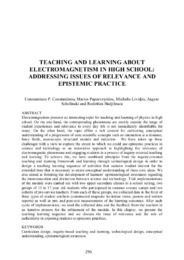| dc.contributor.author | Constantinou, Constantinos P. | en |
| dc.contributor.author | Papaevripidou, Marios | en |
| dc.contributor.author | Lividjis, Michalis | en |
| dc.contributor.author | Scholinaki, Argyro | en |
| dc.contributor.author | Hadjilouca, Rodothea | en |
| dc.coverage.spatial | CY - Λευκωσία | en |
| dc.date.accessioned | 2016-01-25T06:19:01Z | |
| dc.date.available | 2016-01-25T06:19:01Z | |
| dc.date.issued | 2008 | |
| dc.identifier.uri | http://hdl.handle.net/10797/14492 | en |
| dc.description | Περιέχει το πλήρες κείμενο | el_GR |
| dc.description.abstract | Electromagnetism presents an interesting topic for teaching and learning of physics in high
school. On the one hand, the corresponding phenomena are mostly outside the range of
student experiences and relevance to every day life is not immediately identifiable for
many. On the other hand, the topic offers a rich context for cultivating conceptual
understanding of a progression of core scientific concepts such as interaction at a distance,
force fields, mesoscopic structural models and induction. We have taken up these
challenges with a view to explore the extent to which we could use epistemic practices in
science and technology as an innovative approach to highlighting the relevance of
electromagnetic phenomena and engaging students in a process of inquiry oriented teaching
and learning. To achieve this, we have combined principles from the inquiry-oriented
teaching and learning framework and learning through technological design in order to
design a teaching learning sequence of activities that sustains student interest for the
extended time that is necessary to attain conceptual understanding of these core ideas. We
also aimed at fostering the development of learners’ epistemological awareness regarding
the interconnection and distinction between science and technology. Trial implementations
of the module were carried out with two upper secondary classes in a school setting, two
groups of 15 to 17 year old students who participated in summer science camps and two
cohorts of pre-service teachers. From each of these groups, we collected data in the form of
three types of student artefacts (constructed magnetic levitation trains, posters and written
reports) as well as pre- and post-test measurements of the learning outcomes. After each
cycle of implementation, we used the collected data and the feedback from the teachers in
an iterative process for the refinement of the module. In this chapter, we present the
teaching learning sequence and we discuss the issue of relevance and the role of
authenticity in exposing students to epistemic practices. | en |
| dc.language.iso | eng | en |
| dc.publisher | University of Cyprus | en |
| dc.relation.ispartof | Curriculum design | en |
| dc.rights | info:eu-repo/semantics/openAccess | en |
| dc.title | Teaching and learning about Electromagnetism in high school: addressing issues of relevance and Epistemic practice | en |
| dc.type | info:eu-repo/semantics/conferenceObject | en |
| dc.subject.uncontrolledterm | Curriculum design | en |
| dc.subject.uncontrolledterm | Inquiry-based teaching and learning | en |
| dc.subject.uncontrolledterm | Technological design | en |
| dc.subject.uncontrolledterm | Conceptual understanding | en |
| dc.subject.uncontrolledterm | Epistemological awareness | en |
| dc.contributor.conferenceorganizer | Department of Educational Science, University of Cyprus | en |
